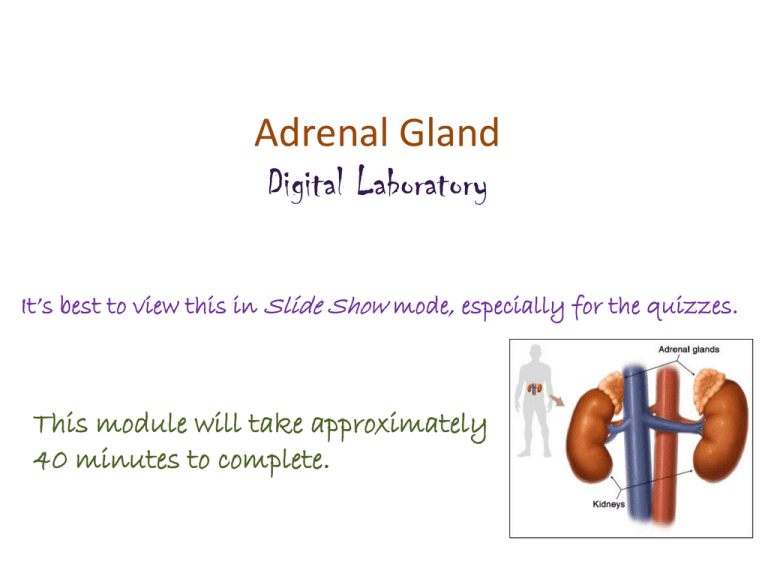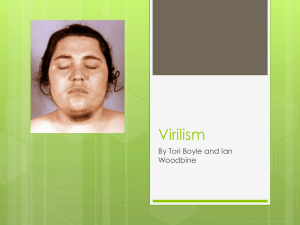Adrenal Gland
advertisement

Adrenal Gland Digital Laboratory It’s best to view this in Slide Show mode, especially for the quizzes. This module will take approximately 40 minutes to complete. After completing this exercise, you should be able to: identify, at the light microscope level, each of the following: • Adrenal gland • Cortex • Zona glomerulosa • Zona fasciculata • Zona reticularis • Medulla • Medullary cells (chromaphin cells) • Central vein • Smooth muscle identify, at the electron microscope level • Adrenal gland • Cortex vs. medulla The adrenal glands are located in the posterior abdominal wall, situated above the kidneys. They develop from two tissues: 1. Intermediate mesoderm, which forms the adrenal cortex 2. Neural crest cells, which form the adrenal medulla Connective tissue and other stuff Adrenal gland outlined in green above, and dashed blue below. In both cases, the border between the medulla and cortex is indicated by the tips of the arrows. Because the adrenal gland is derived from two different sources, the cortex and medulla are histologically and functionally distinct: 1. The adrenal cortex (outer portion) – secretes steroid hormones 2. The adrenal medulla (inner portion) – secretes epinephrine and norepinephrine The main cells of the medulla, the chromaffin cells, can be thought of as modified postganglionic sympathetic neurons. Compare the sympathetic innervation of other organs (for example, the heart, below) to that of the adrenal to see why. e.g., symp. chain ganglion Pre-ganglionic Symp. neuron Post-ganglionic Symp. neuron Pre-ganglionic symp. neuron Symp. stimulation elicits a targeted response of the heart Norepinephrine Symp. stimulation elicits a widespread response Video of adrenal gland showing overview – SL127 Video of adrenal gland showing overview – SL52 Link to SL 127 and SL 052 Be able to identify: •Adrenal gland •Cortex •Medulla Cap = capsule A = arteriole The adrenal cortex can be divided into three zones: 1. Zona glomerulosa (ZG) – secretes mineralcorticoids, mainly aldosterone 2. Zona fasciculata (ZF) – secretes glucocorticoids, mainly cortisol 3. Zona reticularis (ZR) – secrete weak androgens The steroid-secreting cells in all three regions contain lipid droplets , making them pale in H&E stained sections (lipid is extracted away). Note, however, that the fasciculata is the palest, and the reticularis is darkest. Cells in the glomerulosa and reticularis tend to organize in round clusters, but cells in the fasciculata organize into columns. Video of adrenal gland showing cortex – SL127 Video of adrenal gland showing cortex – SL52 Link to SL 127 and SL 052 Be able to identify: •Adrenal cortex •Zona glomerulosa •Zona fasciculata •Zona reticularis Arrowheads indicate borders between adjacent cells. Circle inset contains enlarged region of cell cytoplasm. This is an electron micrograph of the zona fasciculata. Three characteristic features are typical of steroid-secreting cells: 1. Numerous lipid droplets - labeled L, poor preparation of this tissue gives them their unusual appearance here 2. Smooth endoplasmic reticulum – shown in the inset 3. Mitochondria with tubular cristae – red arrows, an enlarged view of a similar mitochondrion is to the right, note sectioned tubular cristae are round, and not “shelf-like” as in typical mitochondria The adrenal medulla (brackets) secretes epinephrine and norepinephrine. It typically does not preserve well, so it’s organization and staining is not well-demonstrated on most slides. Nevertheless, because it is adjacent to, and stains “differently” from the cortex, it is readily identified. Both of these images are from the adrenal medulla. The one on the right is the adrenal slide in which the hematoxylin is understained. As you can see, the chromaffin cells vary in size and staining intensity, both between specimens and on the same section. Typically, their nuclei are relatively euchromatic, though many remain small. Honestly, by themselves, these cells don’t have much to hang your hat on. The best way to identify adrenal medulla is in the context of the entire adrenal gland. Video of adrenal gland showing medulla – SL127 Video of adrenal gland showing medulla – SL52 Link to SL 127 and SL 052 Be able to identify: •Adrenal medulla •Medullary (chromaffin) cells In electron micrographs, abundant dense secretory granules are seen in chromaffin cells of the adrenal medulla. The norepinephrine (NE) granules can be distinguished from those containing epinephrine (E) because they are denser, but we do not require you to make this distinction. Particularly note the difference between these cells of the adrenal medulla, which contain dense secretory granules, from cells of the adrenal cortex, which have lipid droplets, SER, and mitochondria with tubular cristae. If you have been paying attention, you might be thinking: “These cells look a lot like those in the anterior pituitary. How do I know which is which?” The answer is you really can’t at this high magnification unless you are told the source of the tissue. The same is true if you compare cells of the adrenal cortex with other steroid-secreting cells (e.g. Leydig cells/secrete testosterone) you will see later. Like all endocrine organs, the adrenal gland has a rich blood supply, highlighted by capillaries that are fenestrated. In the adrenal cortex, like the anterior pituitary, the vessels are referred to as sinusoids. (Again, we will discuss the different types of capillaries in the cardiovascular block.) The adrenal medulla receives both direct arterial blood (unbranched vertical vessel on the right side of the drawing), as well as blood that has already percolated through the cortex, picking up steroid hormones (left vertical vessels). Because of this circulatory arrangement, although the cortex and medulla are derived from different tissues embryologically and release distinct types of hormones, the activity of the cortex has an influence on the activity of the medulla. The capillaries in the cortex tend to match the organization of the cells; convoluted vessels in the glomerulosa and reticularis, longitudinal vessels in the fasciculata. Video of adrenal gland showing sinusoids – SL127 Video of adrenal gland showing sinusoids – SL52 Link to SL 127 and SL 052 Be able to identify: •Sinusoids (not in the objectives, but you are scholars of histology) Another unusual feature of adrenal circulation is the central medullary vein, which drains blood from the adrenal gland. Veins typically have very little smooth muscle. The central medullary vein, however, has thick bundles of smooth muscle that run longitudinally. Contraction of these muscles reduces the size of the adrenal gland; it is thought that this action enhances the release of hormones from the adrenal medulla. Video of adrenal gland showing the central vein – SL127 Video of adrenal gland showing the central vein – SL52 Link to SL 127 and SL 052 Be able to identify: •Central medullary vein •Smooth muscle The next set of slides is a quiz for this module. You should review the structures covered in this module, and try to visualize each of these in light and electron micrographs. identify, at the light microscope level, each of the following: • Adrenal gland • Cortex • Zona glomerulosa • Zona fasciculata • Zona reticularis • Medulla • Medullary cells (chromaphin cells) • Central vein • Smooth muscle identify, at the electron microscope level • Adrenal gland • Cortex vs. medulla Self-check: Identify the tissue. (advance slide for answers) Self-check: Identify the region. (advance slide for answers) Self-check: Identify the outlined region. Be specific. (advance slide for answers) Self-check: If this image was taken from the adrenal gland, from which part of that gland could this have been obtained. (advance slide for answers) Any of the three zones would be acceptable. This happens to show mostly fasciculata – note the large number of lipid droplets in the cells. Self-check: Identify the predominant tissue in this image. (advance slide for answers) Self-check: Identify region. (advance slide for answers) Self-check: Identify the tissue in the outlined region. (advance slide for answers) Self-check: Identify the region indicated by the brackets. (advance slide for answers) Self-check: This is a section from the adrenal gland. Identify the region from which this was taken. Identify 4. (advance slide for answers) 4. Blood vessel Self-check: Identify the region indicated by the brackets. (advance slide for answers) Self-check: If this image was taken from the adrenal gland, from which part of that gland could this have been obtained. (advance slide for answers) Self-check: Identify the outlined tissues. (advance slide for answers) Self-check: Identify the region. (advance slide for answers) Self-check: Identify the tissue in the outlined region. (advance slide for answers) Self-check: This is a section from the posterior pituitary (neurohypophysis). Identify the predominant structure in this image. (advance slide for answers) Self-check: Identify the tissue closest to the arrows. (advance slide for answers) Self-check: Identify the organ. Be specific. (advance slide for answers) Self-check: Identify the region. (advance slide for answers) Self-check: Identify the region indicated by the brackets. (advance slide for answers) Self-check: This is a from the adrenal gland. Identify the region from which this was taken. Identify 2, 3, 6, and 7. (advance slide for answers) 2. Mitochondria with tubular cristae 3. Golgi apparatus 6 & 7 Lipid droplets Self-check: Identify the outlined structure. Be specific. (advance slide for answers)









